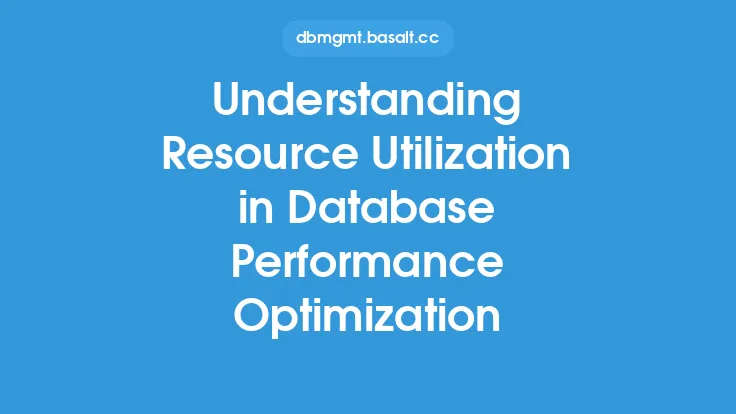Database workloads are a critical component of any database system, as they directly impact the performance, efficiency, and scalability of the database. One key aspect of database workloads is resource utilization, which refers to the way in which the database uses system resources such as CPU, memory, storage, and network bandwidth. Understanding resource utilization patterns in database workloads is essential for optimizing database performance, identifying potential bottlenecks, and ensuring that the database is able to handle changing workloads and user demands.
Introduction to Resource Utilization Patterns
Resource utilization patterns in database workloads can be complex and varied, depending on the specific use case, database design, and system configuration. However, there are some common patterns that can be observed in many database systems. For example, many databases experience a daily cycle of activity, with peak usage during business hours and lower usage during evenings and weekends. This cycle can be influenced by factors such as user behavior, batch processing, and maintenance activities. Additionally, databases may experience seasonal fluctuations in usage, such as increased activity during holiday periods or special events.
Types of Resource Utilization Patterns
There are several types of resource utilization patterns that can be observed in database workloads, including:
- CPU-bound workloads: These workloads are characterized by high CPU usage, often due to complex queries, indexing, or other compute-intensive operations. CPU-bound workloads can be optimized by improving query performance, indexing, and partitioning, as well as by adding more CPU resources.
- Memory-bound workloads: These workloads are characterized by high memory usage, often due to large result sets, sorting, or other memory-intensive operations. Memory-bound workloads can be optimized by improving query performance, indexing, and caching, as well as by adding more memory resources.
- I/O-bound workloads: These workloads are characterized by high disk I/O usage, often due to large amounts of data being read or written to disk. I/O-bound workloads can be optimized by improving disk performance, using solid-state drives (SSDs), and optimizing disk layout and configuration.
- Network-bound workloads: These workloads are characterized by high network usage, often due to large amounts of data being transferred between nodes or systems. Network-bound workloads can be optimized by improving network performance, using faster network protocols, and optimizing data transfer algorithms.
Factors Influencing Resource Utilization Patterns
Several factors can influence resource utilization patterns in database workloads, including:
- Database design: The design of the database, including the schema, indexing, and partitioning, can significantly impact resource utilization patterns. A well-designed database can reduce resource usage and improve performance, while a poorly designed database can lead to increased resource usage and decreased performance.
- Query patterns: The types of queries executed against the database can impact resource utilization patterns. For example, complex queries with multiple joins and subqueries can be CPU-intensive, while simple queries with few joins and subqueries can be less resource-intensive.
- Data distribution: The distribution of data within the database can impact resource utilization patterns. For example, a database with a large number of small tables may experience higher I/O usage than a database with a small number of large tables.
- System configuration: The configuration of the database system, including the operating system, storage, and network, can impact resource utilization patterns. For example, a system with a high-performance storage subsystem may experience lower I/O usage than a system with a lower-performance storage subsystem.
Analyzing Resource Utilization Patterns
Analyzing resource utilization patterns in database workloads is essential for optimizing database performance and identifying potential bottlenecks. Several tools and techniques can be used to analyze resource utilization patterns, including:
- Monitoring tools: Monitoring tools such as Oracle Enterprise Manager, SQL Server Management Studio, and MySQL Workbench can provide detailed information about resource utilization patterns, including CPU, memory, disk I/O, and network usage.
- Logging and tracing: Logging and tracing tools can provide detailed information about query execution, including the resources used and the time taken to execute each query.
- Benchmarking: Benchmarking tools can be used to simulate different workloads and measure the resulting resource utilization patterns.
- Capacity planning: Capacity planning tools can be used to model and predict future resource utilization patterns, based on historical trends and projected growth.
Optimizing Resource Utilization Patterns
Optimizing resource utilization patterns in database workloads is essential for improving database performance, reducing costs, and ensuring that the database is able to handle changing workloads and user demands. Several techniques can be used to optimize resource utilization patterns, including:
- Query optimization: Query optimization techniques such as indexing, caching, and rewriting queries can reduce resource usage and improve performance.
- Database design optimization: Database design optimization techniques such as partitioning, denormalization, and data compression can reduce resource usage and improve performance.
- System configuration optimization: System configuration optimization techniques such as adjusting buffer pool sizes, optimizing disk layout, and configuring network protocols can reduce resource usage and improve performance.
- Resource allocation: Resource allocation techniques such as allocating more resources to critical systems, prioritizing resource usage, and using resource governance tools can ensure that resources are used efficiently and effectively.
Best Practices for Managing Resource Utilization Patterns
Several best practices can be followed to manage resource utilization patterns in database workloads, including:
- Monitor resource utilization: Monitor resource utilization patterns regularly to identify potential bottlenecks and optimize resource usage.
- Analyze query patterns: Analyze query patterns to identify opportunities for optimization and reduce resource usage.
- Optimize database design: Optimize database design to reduce resource usage and improve performance.
- Configure system resources: Configure system resources such as buffer pool sizes, disk layout, and network protocols to optimize resource usage and improve performance.
- Use resource governance tools: Use resource governance tools to prioritize resource usage, allocate resources to critical systems, and ensure that resources are used efficiently and effectively.





